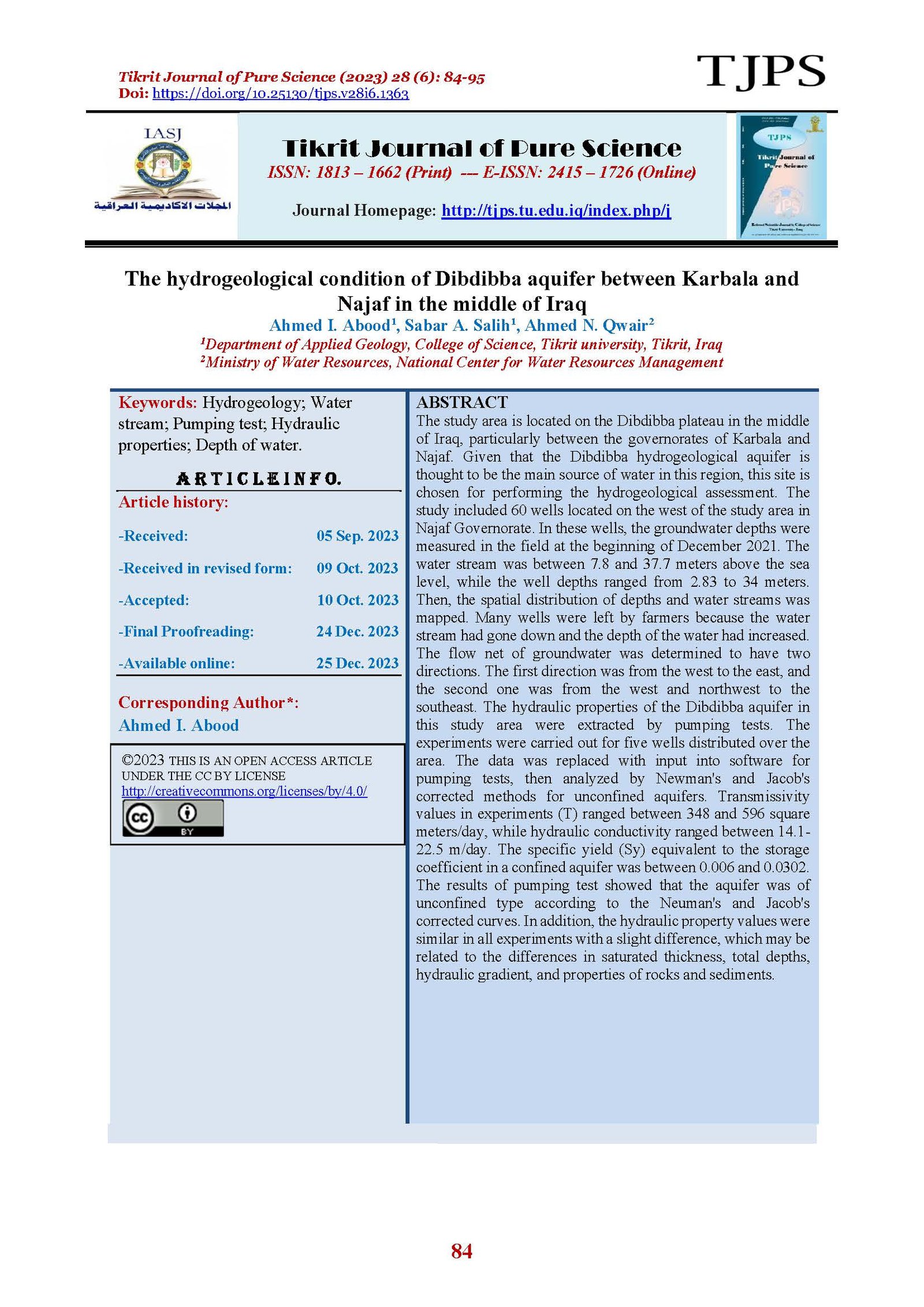The Hydrogeological Condition of Dibdibba aquifer between Karbala and Najaf in the middle of Iraq
Main Article Content
Abstract
The study area is located on the Dibdibba plateau in the middle of Iraq, particularly between the governorates of Karbala and Najaf. Given that the Dibdibba hydrogeological aquifer is thought to be the main source of water in this region, this site is chosen for performing the hydrogeological assessment. The study included 60 wells located on the west of the study area in Najaf Governorate. In these wells, the groundwater depths were measured in the field at the beginning of December 2021. The water stream was between 7.8 and 37.7 meters above the sea level, while the well depths ranged from 2.83 to 34 meters. Then, the spatial distribution of depths and water streams was mapped. Many wells were left by farmers because the water stream had gone down and the depth of the water had increased. The flow net of groundwater was determined to have two directions. The first direction was from the west to the east, and the second one was from the west and northwest to the southeast. The hydraulic properties of the Dibdibba aquifer in this study area were extracted by pumping tests. The experiments were carried out for five wells distributed over the area. The data was replaced with input into software for pumping tests, then analyzed by Newman's and Jacob's corrected methods for unconfined aquifers. Transmissivity values in experiments (T) ranged between 348 and 596 square meters/day, while hydraulic conductivity ranged between 14.1-22.5 m/day. The specific yield (Sy) equivalent to the storage coefficient in a confined aquifer was between 0.006 and 0.0302. The results of pumping test showed that the aquifer was of unconfined type according to the Neuman's and Jacob's corrected curves. In addition, the hydraulic property values were similar in all experiments with a slight difference, which may be related to the differences in saturated thickness, total depths, hydraulic gradient, and properties of rocks and sediments.
Article Details

This work is licensed under a Creative Commons Attribution 4.0 International License.
Tikrit Journal of Pure Science is licensed under the Creative Commons Attribution 4.0 International License, which allows users to copy, create extracts, abstracts, and new works from the article, alter and revise the article, and make commercial use of the article (including reuse and/or resale of the article by commercial entities), provided the user gives appropriate credit (with a link to the formal publication through the relevant DOI), provides a link to the license, indicates if changes were made, and the licensor is not represented as endorsing the use made of the work. The authors hold the copyright for their published work on the Tikrit J. Pure Sci. website, while Tikrit J. Pure Sci. is responsible for appreciate citation of their work, which is released under CC-BY-4.0, enabling the unrestricted use, distribution, and reproduction of an article in any medium, provided that the original work is properly cited.
References
1. Dillon, P., Stuyfzand, P., Grichek, T., LIuria, M., Pyne, R., Jain, R., Bear, J., Schwarz, J., Wang, W., and Fernández, E. (2019). Hydrogeology journal 27, 1-30
2. Saleh, S. A., Abdulrahman, O. R., & Salih, A. M. (2018). Innovated method to estimate the water income in the section of Tharthar Valley near the Site of Hatra Proposed Dam. Tikrit Journal of Pure Science, 22(6), 88-102.
3. Al- Ansari, N. (2018). Al Jazeera Center for Studies, The Risks of the Water Crisis in Iraq, Report.
4. Jassim, S. Z. and Goff, J. C. (2006). Geology of Iraq. DOLIN, sro, distributed by Geological Society of London
5. Al-Jiburi, H.K. and Al-Basrawi, N.H. (2015). Hydrogeological map of Iraq, scale 1: 1000 000, 2nd edition, Iraqi Bulletin of Geology and Mining, Vol.11, No.1, p. 17-26.
6. Kresic, N. (2023). Hydrogeology 101, Introduction to Groundwater Science and Engineering, Published by Blue Ridge Press LLC, Book, Lecture 2,3, P27, 32,34.
7. Neuman, S. P. (1979). Perspective on ‘delayed yield’. Water Resources Research, 15(4), 899-908.
8. Cooper Jr, H. H., & Jacob, C. E. (1946). A generalized graphical method for evaluating formation constants and summarizing well‐field history. Eos, Transactions American Geophysical Union, 27(4), 526-534.
9. Kruseman, G.P., and de Ridder, N.A. (1990). Analysis and Evaluation of Pumping Test Data. 2nd ed., for Land Reclamation, Wageningen, the Netherlands, 377p.
